2002 BMW 540I SEDAN inflation pressure
[x] Cancel search: inflation pressurePage 99 of 186
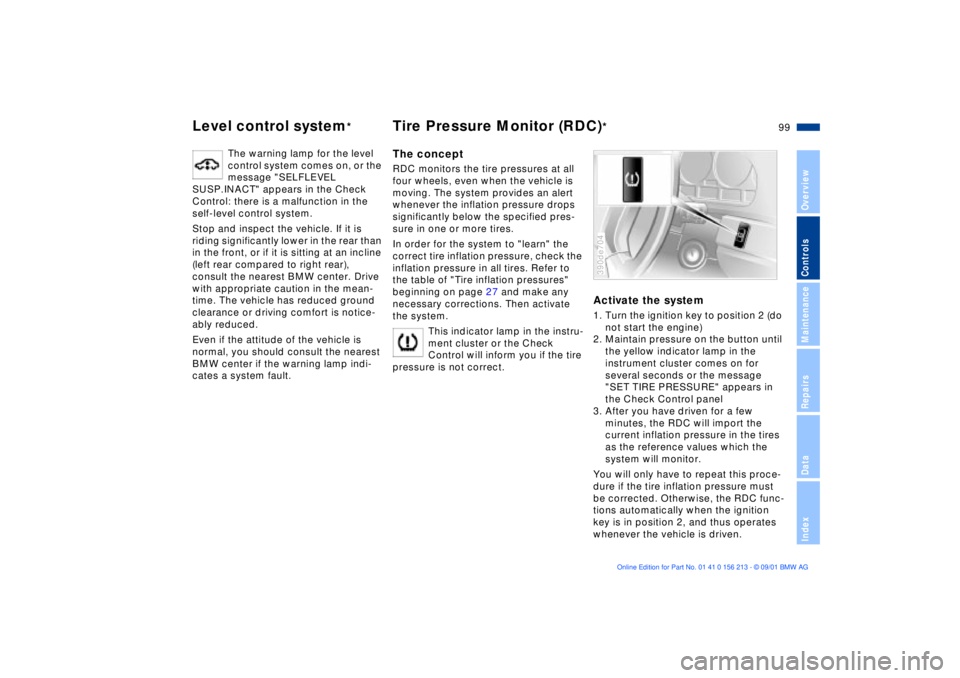
99n
OverviewControlsMaintenanceRepairsDataIndex
Level control system
*
Tire Pressure Monitor (RDC)
*
The warning lamp for the level
control system comes on, or the
message "SELFLEVEL
SUSP.INACT" appears in the Check
Control: there is a malfunction in the
self-level control system.
Stop and inspect the vehicle. If it is
riding significantly lower in the rear than
in the front, or if it is sitting at an incline
(left rear compared to right rear),
consult the nearest BMW center. Drive
with appropriate caution in the mean-
time. The vehicle has reduced ground
clearance or driving comfort is notice-
ably reduced.
Even if the attitude of the vehicle is
normal, you should consult the nearest
BMW center if the warning lamp indi-
cates a system fault.
The conceptRDC monitors the tire pressures at all
four wheels, even when the vehicle is
moving. The system provides an alert
whenever the inflation pressure drops
significantly below the specified pres-
sure in one or more tires.
In order for the system to "learn" the
correct tire inflation pressure, check the
inflation pressure in all tires. Refer to
the table of "Tire inflation pressures"
beginning on page 27 and make any
necessary corrections. Then activate
the system.
This indicator lamp in the instru-
ment cluster or the Check
Control will inform you if the tire
pressure is not correct.
Activate the system1. Turn the ignition key to position 2 (do
not start the engine)
2. Maintain pressure on the button until
the yellow indicator lamp in the
instrument cluster comes on for
several seconds or the message
"SET TIRE PRESSURE" appears in
the Check Control panel
3. After you have driven for a few
minutes, the RDC will import the
current inflation pressure in the tires
as the reference values which the
system will monitor.
You will only have to repeat this proce-
dure if the tire inflation pressure must
be corrected. Otherwise, the RDC func-
tions automatically when the ignition
key is in position 2, and thus operates
whenever the vehicle is driven.390de704
Page 100 of 186
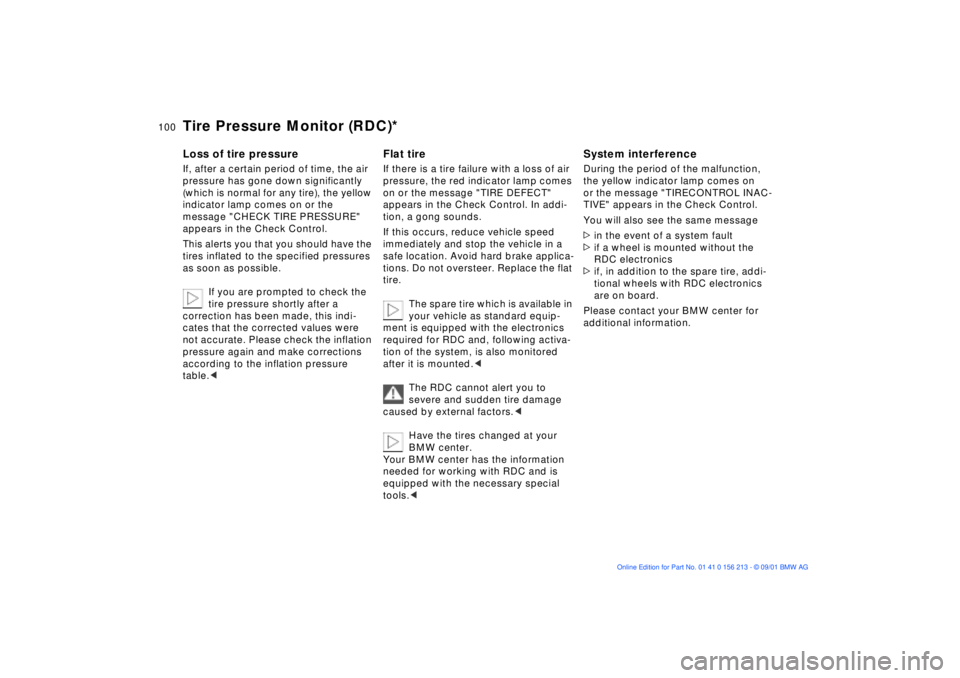
100n
Tire Pressure Monitor (RDC)*Loss of tire pressureIf, after a certain period of time, the air
pressure has gone down significantly
(which is normal for any tire), the yellow
indicator lamp comes on or the
message "CHECK TIRE PRESSURE"
appears in the Check Control.
This alerts you that you should have the
tires inflated to the specified pressures
as soon as possible.
If you are prompted to check the
tire pressure shortly after a
correction has been made, this indi-
cates that the corrected values were
not accurate. Please check the inflation
pressure again and make corrections
according to the inflation pressure
table.<
Flat tireIf there is a tire failure with a loss of air
pressure, the red indicator lamp comes
on or the message "TIRE DEFECT"
appears in the Check Control. In addi-
tion, a gong sounds.
If this occurs, reduce vehicle speed
immediately and stop the vehicle in a
safe location. Avoid hard brake applica-
tions. Do not oversteer. Replace the flat
tire.
The spare tire which is available in
your vehicle as standard equip-
ment is equipped with the electronics
required for RDC and, following activa-
tion of the system, is also monitored
after it is mounted.<
The RDC cannot alert you to
severe and sudden tire damage
caused by external factors.<
Have the tires changed at your
BMW center.
Your BMW center has the information
needed for working with RDC and is
equipped with the necessary special
tools.<
System interferenceDuring the period of the malfunction,
the yellow indicator lamp comes on
or the message "TIRECONTROL INAC-
TIVE" appears in the Check Control.
You will also see the same message
>in the event of a system fault
>if a wheel is mounted without the
RDC electronics
>if, in addition to the spare tire, addi-
tional wheels with RDC electronics
are on board.
Please contact your BMW center for
additional information.
Page 133 of 186
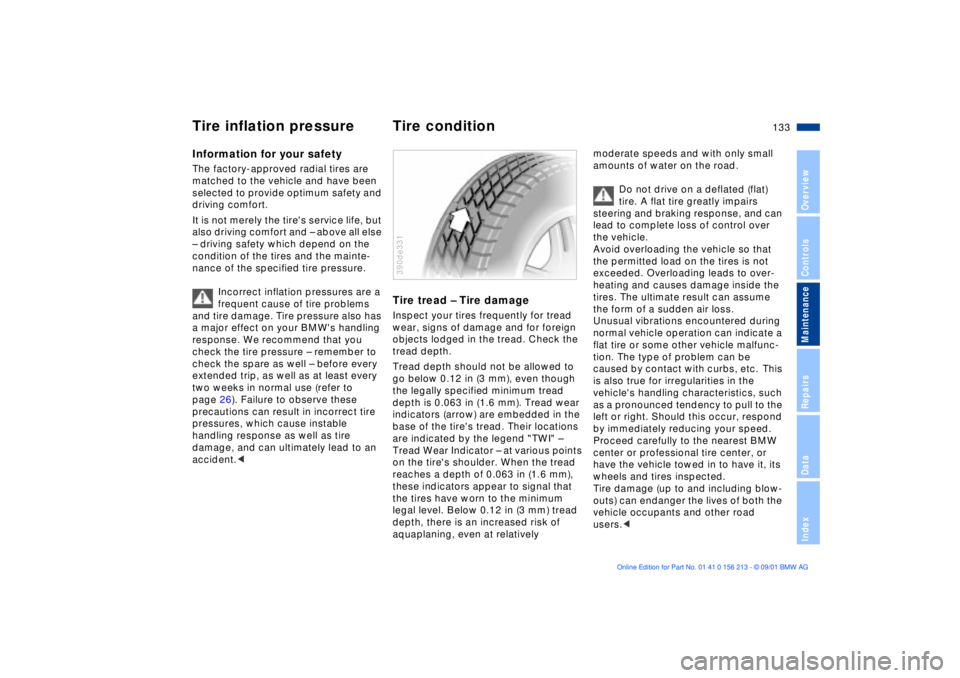
133n
OverviewControlsMaintenanceRepairsDataIndex
Information for your safetyThe factory-approved radial tires are
matched to the vehicle and have been
selected to provide optimum safety and
driving comfort.
It is not merely the tire's service life, but
also driving comfort and Ð above all else
Ð driving safety which depend on the
condition of the tires and the mainte-
nance of the specified tire pressure.
Incorrect inflation pressures are a
frequent cause of tire problems
and tire damage. Tire pressure also has
a major effect on your BMW's handling
response. We recommend that you
check the tire pressure Ð remember to
check the spare as well Ð before every
extended trip, as well as at least every
two weeks in normal use (refer to
page 26). Failure to observe these
precautions can result in incorrect tire
pressures, which cause instable
handling response as well as tire
damage, and can ultimately lead to an
accident.<
Tire tread Ð Tire damageInspect your tires frequently for tread
wear, signs of damage and for foreign
objects lodged in the tread. Check the
tread depth.
Tread depth should not be allowed to
go below 0.12 in (3 mm), even though
the legally specified minimum tread
depth is 0.063 in (1.6 mm). Tread wear
indicators (arrow) are embedded in the
base of the tire's tread. Their locations
are indicated by the legend "TWI" Ð
Tread Wear Indicator Ð at various points
on the tire's shoulder. When the tread
reaches a depth of 0.063 in (1.6 mm),
these indicators appear to signal that
the tires have worn to the minimum
legal level. Below 0.12 in (3 mm) tread
depth, there is an increased risk of
aquaplaning, even at relatively 390de331
moderate speeds and with only small
amounts of water on the road.
Do not drive on a deflated (flat)
tire. A flat tire greatly impairs
steering and braking response, and can
lead to complete loss of control over
the vehicle.
Avoid overloading the vehicle so that
the permitted load on the tires is not
exceeded. Overloading leads to over-
heating and causes damage inside the
tires. The ultimate result can assume
the form of a sudden air loss.
Unusual vibrations encountered during
normal vehicle operation can indicate a
flat tire or some other vehicle malfunc-
tion. The type of problem can be
caused by contact with curbs, etc. This
is also true for irregularities in the
vehicle's handling characteristics, such
as a pronounced tendency to pull to the
left or right. Should this occur, respond
by immediately reducing your speed.
Proceed carefully to the nearest BMW
center or professional tire center, or
have the vehicle towed in to have it, its
wheels and tires inspected.
Tire damage (up to and including blow-
outs) can endanger the lives of both the
vehicle occupants and other road
users.<
Tire inflation pressure Tire condition
Page 136 of 186
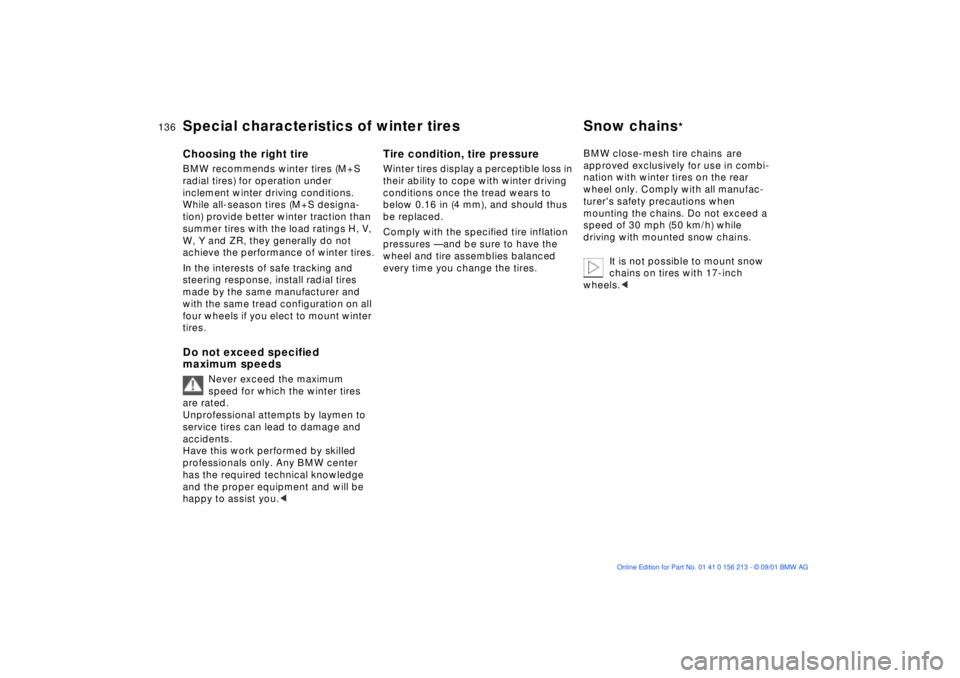
136n
Special characteristics of winter tires Snow chains
*
Choosing the right tireBMW recommends winter tires (M+S
radial tires) for operation under
inclement winter driving conditions.
While all-season tires (M+S designa-
tion) provide better winter traction than
summer tires with the load ratings H, V,
W, Y and ZR, they generally do not
achieve the performance of winter tires.
In the interests of safe tracking and
steering response, install radial tires
made by the same manufacturer and
with the same tread configuration on all
four wheels if you elect to mount winter
tires.Do not exceed specified
maximum speeds
Never exceed the maximum
speed for which the winter tires
are rated.
Unprofessional attempts by laymen to
service tires can lead to damage and
accidents.
Have this work performed by skilled
professionals only. Any BMW center
has the required technical knowledge
and the proper equipment and will be
happy to assist you.<
Tire condition, tire pressureWinter tires display a perceptible loss in
their ability to cope with winter driving
conditions once the tread wears to
below 0.16 in (4 mm), and should thus
be replaced.
Comply with the specified tire inflation
pressures Ñ and be sure to have the
wheel and tire assemblies balanced
every time you change the tires.BMW close-mesh tire chains
are
approved exclusively for use in combi-
nation with winter tires on the rear
wheel only. Comply with all manufac-
turer's safety precautions when
mounting the chains. Do not exceed a
speed of 30 mph (50 km/h) while
driving with mounted snow chains.
It is not possible to mount snow
chains on tires with 17-inch
wheels.<
Page 159 of 186
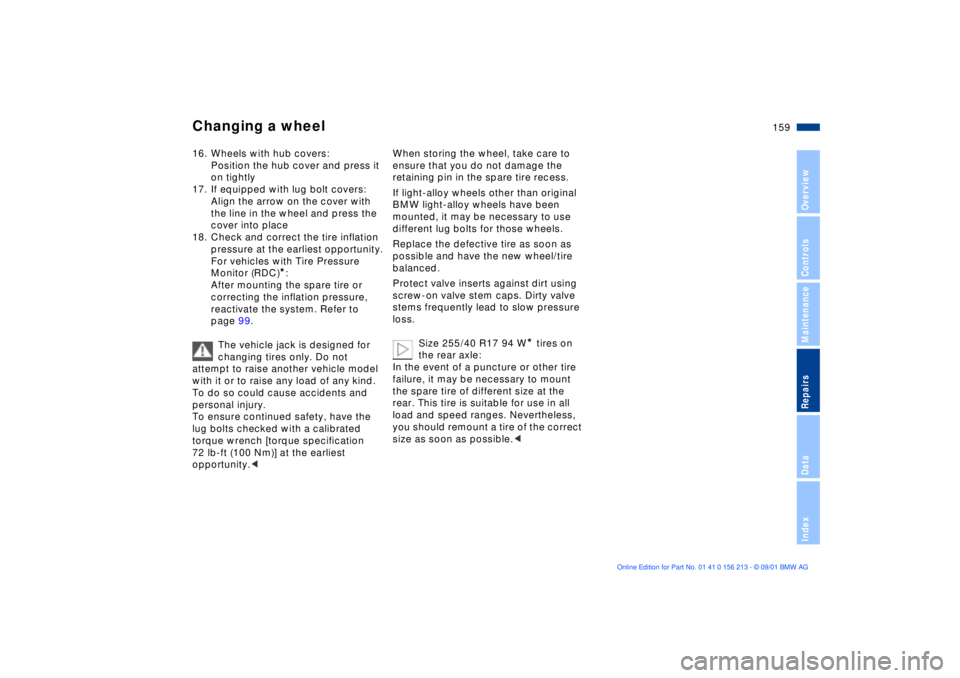
159n
OverviewControlsMaintenanceRepairsDataIndex
Changing a wheel16. Wheels with hub covers:
Position the hub cover and press it
on tightly
17. If equipped with lug bolt covers:
Align the arrow on the cover with
the line in the wheel and press the
cover into place
18. Check and correct the tire inflation
pressure at the earliest opportunity.
For vehicles with Tire Pressure
Monitor (RDC)
*:
After mounting the spare tire or
correcting the inflation pressure,
reactivate the system. Refer to
page 99.
The vehicle jack is designed for
changing tires only. Do not
attempt to raise another vehicle model
with it or to raise any load of any kind.
To do so could cause accidents and
personal injury.
To ensure continued safety, have the
lug bolts checked with a calibrated
torque wrench [torque specification
72 lb-ft (100 Nm)] at the earliest
opportunity.<
When storing the wheel, take care to
ensure that you do not damage the
retaining pin in the spare tire recess.
If light-alloy wheels other than original
BMW light-alloy wheels have been
mounted, it may be necessary to use
different lug bolts for those wheels.
Replace the defective tire as soon as
possible and have the new wheel/tire
balanced.
Protect valve inserts against dirt using
screw-on valve stem caps. Dirty valve
stems frequently lead to slow pressure
loss.
Size 255/40 R17 94 W
* tires on
the rear axle:
In the event of a puncture or other tire
failure, it may be necessary to mount
the spare tire of different size at the
rear. This tire is suitable for use in all
load and speed ranges. Nevertheless,
you should remount a tire of the correct
size as soon as possible.<
Page 179 of 186
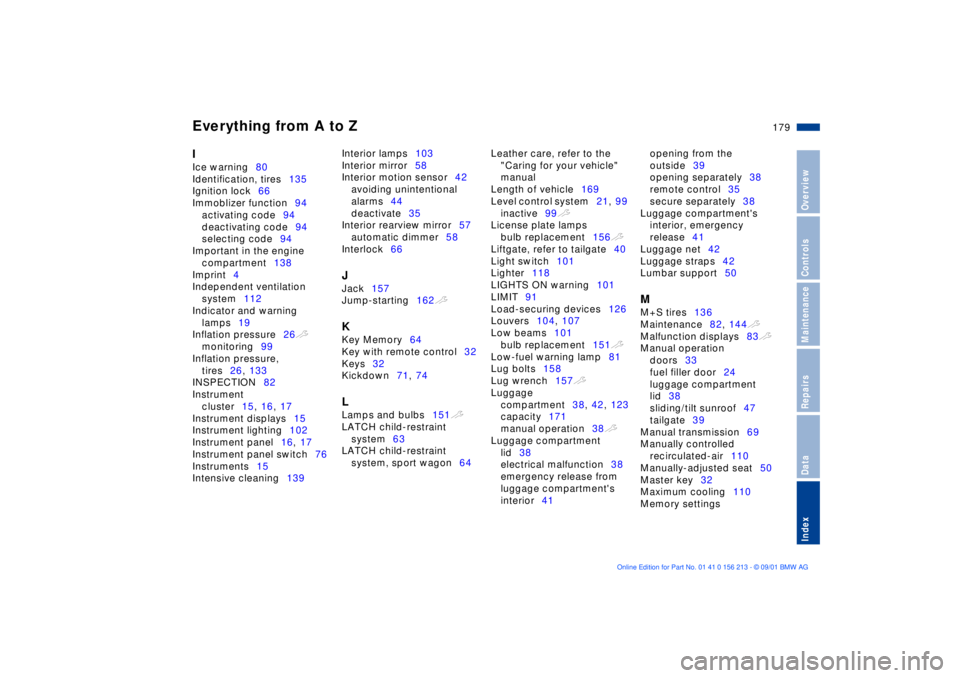
Everything from A to Z
179n
OverviewControlsMaintenanceRepairsDataIndex
I
Ice warning80
Identification, tires135
Ignition lock66
Immoblizer function94
activating code94
deactivating code94
selecting code94
Important in the engine
compartment138
Imprint4
Independent ventilation
system112
Indicator and warning
lamps19
Inflation pressure26t
monitoring99
Inflation pressure,
tires26, 133
INSPECTION82
Instrument
cluster15, 16, 17
Instrument displays15
Instrument lighting102
Instrument panel16, 17
Instrument panel switch76
Instruments15
Intensive cleaning139 Interior lamps103
Interior mirror58
Interior motion sensor42
avoiding unintentional
alarms44
deactivate35
Interior rearview mirror57
automatic dimmer58
Interlock66
J
Jack157
Jump-starting162t K
Key Memory64
Key with remote control32
Keys32
Kickdown71, 74 L
Lamps and bulbs151t
LATCH child-restraint
system63
LATCH child-restraint
system, sport wagon64 Leather care, refer to the
"Caring for your vehicle"
manual
Length of vehicle169
Level control system21, 99
inactive99t
License plate lamps
bulb replacement156t
Liftgate, refer to tailgate40
Light switch101
Lighter118
LIGHTS ON warning101
LIMIT91
Load-securing devices126
Louvers104, 107
Low beams101
bulb replacement151t
Low-fuel warning lamp81
Lug bolts158
Lug wrench157t
Luggage
compartment38, 42, 123
capacity171
manual operation38t
Luggage compartment
lid38
electrical malfunction38
emergency release from
luggage compartment's
interior41 opening from the
outside39
opening separately38
remote control35
secure separately38
Luggage compartment's
interior, emergency
release41
Luggage net42
Luggage straps42
Lumbar support50
M
M+S tires136
Maintenance82, 144t
Malfunction displays83t
Manual operation
doors33
fuel filler door24
luggage compartment
lid38
sliding/tilt sunroof47
tailgate39
Manual transmission69
Manually controlled
recirculated-air110
Manually-adjusted seat50
Master key32
Maximum cooling110
Memory settings
Page 180 of 186
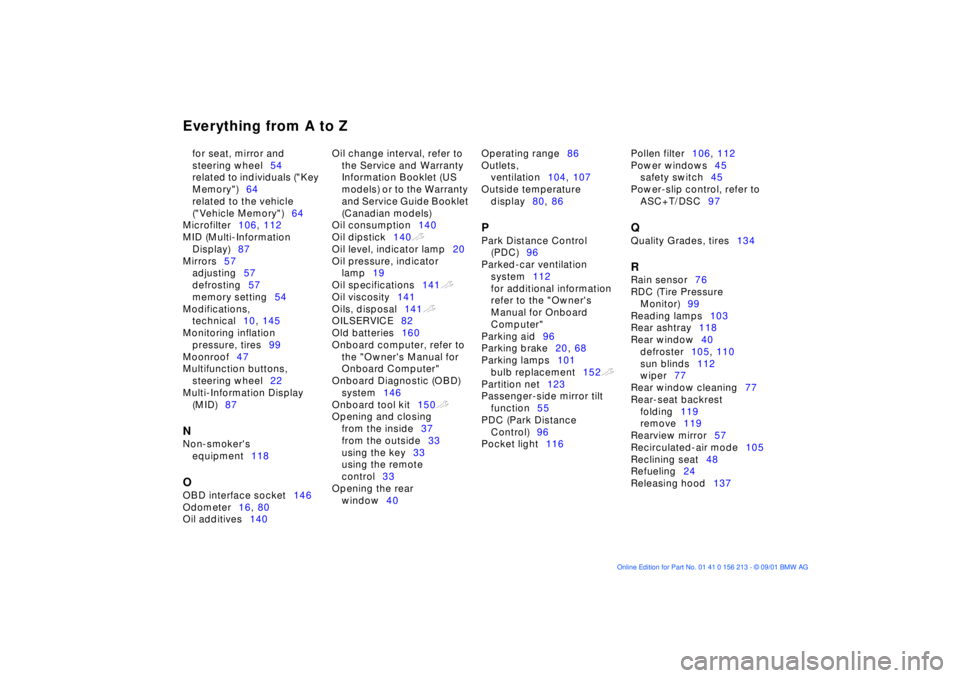
Everything from A to Zfor seat, mirror and
steering wheel54
related to individuals ("Key
Memory")64
related to the vehicle
("Vehicle Memory")64
Microfilter106, 112
MID (Multi-Information
Display)87
Mirrors57
adjusting57
defrosting57
memory setting54
Modifications,
technical10, 145
Monitoring inflation
pressure, tires99
Moonroof47
Multifunction buttons,
steering wheel22
Multi-Information Display
(MID)87 N
Non-smoker's
equipment118 O
OBD interface socket146
Odometer16, 80
Oil additives140 Oil change interval, refer to
the Service and Warranty
Information Booklet (US
models) or to the Warranty
and Service Guide Booklet
(Canadian models)
Oil consumption140
Oil dipstick140t
Oil level, indicator lamp20
Oil pressure, indicator
lamp19
Oil specifications141t
Oil viscosity141
Oils, disposal141t
OILSERVICE82
Old batteries160
Onboard computer, refer to
the "Owner's Manual for
Onboard Computer"
Onboard Diagnostic (OBD)
system146
Onboard tool kit150t
Opening and closing
from the inside37
from the outside33
using the key33
using the remote
control33
Opening the rear
window40 Operating range86
Outlets,
ventilation104, 107
Outside temperature
display80, 86
P
Park Distance Control
(PDC)96
Parked-car ventilation
system112
for additional information
refer to the "Owner's
Manual for Onboard
Computer"
Parking aid96
Parking brake20, 68
Parking lamps101
bulb replacement152t
Partition net123
Passenger-side mirror tilt
function55
PDC (Park Distance
Control)96
Pocket light116 Pollen filter106, 112
Power windows45
safety switch45
Power-slip control, refer to
ASC+T/DSC97
Q
Quality Grades, tires134 R
Rain sensor76
RDC (Tire Pressure
Monitor)99
Reading lamps103
Rear ashtray118
Rear window40
defroster105, 110
sun blinds112
wiper77
Rear window cleaning77
Rear-seat backrest
folding119
remove119
Rearview mirror57
Recirculated-air mode105
Reclining seat48
Refueling24
Releasing hood137
Page 182 of 186
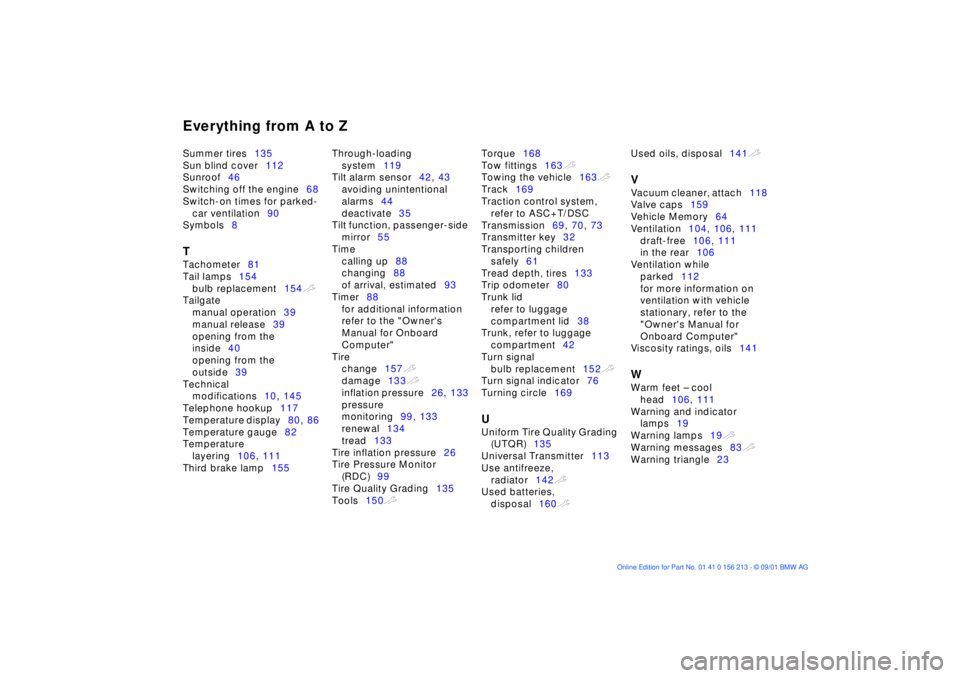
Everything from A to ZSummer tires135
Sun blind cover112
Sunroof46
Switching off the engine68
Switch-on times for parked-
car ventilation90
Symbols8 T
Tachometer81
Tail lamps154
bulb replacement154t
Tailgate
manual operation39
manual release39
opening from the
inside40
opening from the
outside39
Technical
modifications10, 145
Telephone hookup117
Temperature display80, 86
Temperature gauge82
Temperature
layering106, 111
Third brake lamp155 Through-loading
system119
Tilt alarm sensor42, 43
avoiding unintentional
alarms44
deactivate35
Tilt function, passenger-side
mirror55
Time
calling up88
changing88
of arrival, estimated93
Timer88
for additional information
refer to the "Owner's
Manual for Onboard
Computer"
Tire
change157t
damage133t
inflation pressure26, 133
pressure
monitoring99, 133
renewal134
tread133
Tire inflation pressure26
Tire Pressure Monitor
(RDC)99
Tire Quality Grading135
Tools150t Torque168
Tow fittings163t
Towing the vehicle163t
Track169
Traction control system,
refer to ASC+T/DSC
Transmission69, 70, 73
Transmitter key32
Transporting children
safely61
Tread depth, tires133
Trip odometer80
Trunk lid
refer to luggage
compartment lid38
Trunk, refer to luggage
compartment42
Turn signal
bulb replacement152t
Turn signal indicator76
Turning circle169
U
Uniform Tire Quality Grading
(UTQR)135
Universal Transmitter113
Use antifreeze,
radiator142t
Used batteries,
disposal160t Used oils, disposal141t
V
Vacuum cleaner, attach118
Valve caps159
Vehicle Memory64
Ventilation104, 106, 111
draft-free106, 111
in the rear106
Ventilation while
parked112
for more information on
ventilation with vehicle
stationary, refer to the
"Owner's Manual for
Onboard Computer"
Viscosity ratings, oils141 W
Warm feet Ð cool
head106, 111
Warning and indicator
lamps19
Warning lamps19t
Warning messages83t
Warning triangle23